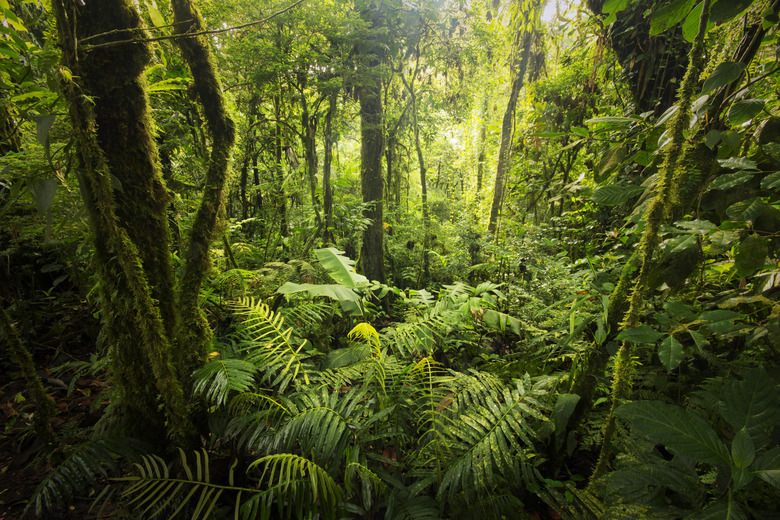Rainforest Weather & Climate
Both equatorial and midlatitude regions contain rainforests, and rainforest weather and climate vary by geography. The two primary types of rainforests are tropical and temperate. A third type, the tropical monsoon forest, resembles the tropical rainforest except for the timing of precipitation. In tropical and temperate rainforests, weather patterns follow two primary seasons, wet and dry.
Wet and Dry Seasons
Wet and Dry Seasons
Temperate rainforests have a long wet season and a short dry season. Rain still falls during the "dry" season, however, but not at the same rate as during the wet season. Much of the dry season precipitation in temperate rainforests comes in the form of fog. The wet and dry seasons in tropical rainforests are more equal. For example, each season is about six months long in the Amazon basin, and the wet season lasts from December to May.
Tropical Rainforest Climate
Tropical Rainforest Climate
Tropical rainforests are located north and south of the equator between the Tropic of Cancer and the Tropic of Capricorn. As such, they have a warm and humid climate with lots of rainfall. Annual precipitation amounts vary greatly from 200 to 1,020 centimeters (80 to 400 inches). In the Amazon rainforest, precipitation can be more than 365 centimeters (12 feet) in a year. Mean temperatures are above 18 degrees Celsius (64 degrees Fahrenheit). The weather will vary during the dry season as rainfall decreases.
Temperate Rainforest Climate
Temperate Rainforest Climate
Temperate rainforests are located in regions such as the northwest portion of the United States, called the Pacific Northwest. Over two-thirds of all temperate rainforests are found in the Pacific Northwest. Mountain ranges protect temperate rainforests from weather extremes, and they typically have moderate weather even though they're located far from the equator. On average, temperate rainforests will receive less rainfall and have cooler temperatures than their tropical counterparts. Precipitation averages approximately 250 centimeters (100 inches) annually. But it will vary from 150 to 500 centimeters (60 to 200 inches) in any given year.
Tropical Monsoon Climate
Tropical Monsoon Climate
Tropical monsoon forests have a climate similar to tropical rainforests, except for rainfall patterns. Monsoon climates are located along coastal areas, which have different air circulation patterns than those seen in a typical tropical rainforest. Temperatures are comparable between the two, and warm air dominates year-round. The amount of average annual precipitation is also similar between tropical monsoon forests and tropical rainforests. Monsoon forests, however, receive most of their precipitation during the peak of summer, or the monsoon season, due to changes in atmospheric circulation.
Cite This Article
MLA
Peterson, John. "Rainforest Weather & Climate" sciencing.com, https://www.sciencing.com/rainforest-weather-climate-19521/. 19 April 2018.
APA
Peterson, John. (2018, April 19). Rainforest Weather & Climate. sciencing.com. Retrieved from https://www.sciencing.com/rainforest-weather-climate-19521/
Chicago
Peterson, John. Rainforest Weather & Climate last modified March 24, 2022. https://www.sciencing.com/rainforest-weather-climate-19521/
